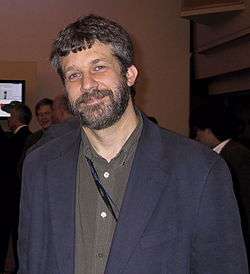Charlie Catlett
Charlie Catlett (born 1960) is a Senior Computer Scientist at Argonne National Laboratory and a Senior Fellow in the Computation Institute, a joint institute of Argonne National Laboratory[1] and The University of Chicago,[2][3] and a Senior Fellow at the University of Chicago's Harris School of Public Policy.

Research
Catlett directs the Urban Center for Computation and Data (UrbanCCD), which brings scientists from mathematics and computing together with social, behavioral, economic, policy, education, and health scientists to better understand cities. Major UrbanCCD initiatives include making urban data discoverable and explorable through platforms such as Plenario and OpenGrid and developing technologies for instrumenting cities through projects such as the Array of Things.
From 2007-2011 he was Chief Information Officer and director of the Computing and Information Systems Division at Argonne National Laboratory. From 2004-2007 he was Director of the TeraGrid Project.[4]
Prior to joining Argonne in 2000, Catlett was Chief Technology Officer at the National Center for Supercomputing Applications (NCSA). He was part of the original team that established NCSA in 1985 and his early work there included participation on the team that deployed and managed the NSFNet. In the early 1990s Catlett participated in the DARPA/NSF Gigabit Testbeds Initiative, coordinated by the Corporation for National Research Initiatives.
Catlett was the founding chair of the Global Grid Forum (GGF, now Open Grid Forum) from 1999 through 2004.[1] During this same period he designed and deployed one of the first regional optical networks dedicated to academic and research use - I-WIRE, funded by the State of Illinois.
He has been involved in Grid (distributed) computing since the early 1990s, when he co-authored (with Larry Smarr) a seminal paper "Metacomputing"[5] in the Communications of the ACM, which outlined many of the high-level goals of what is today called Grid computing.[6]
Selected publications
- "A Report to the President: Technology and the Future of Cities," President's Council of Advisors on Science and Technology, February 2016.
- "Plenario: An Open Data Discovery and Exploration Platform for Urban Science," Charlie Catlett, Tanu Malika, Brett Goldstein, Jonathan Giuffrida, Yetong Shaoa, Alessandro Panella, Derek Eder, Eric van Zanten, Robert Mitchum, Severin Thalerc, Ian Foster, IEEE Computer Society Bulletin of the Technical Committee on Data Engineering, December 2014, Vol. 37 No. 4
- "A Scientific Research and Development Approach to Cyber Security," Charlie Catlett, Editor, A report presented to the Department of Energy Office of Science, December 2008.
- "TeraGrid: Analysis of Organization, System Architecture, and Middleware Enabling New Types of Applications," Charlie Catlett et al., HPC and Grids in Action, ed. Lucio Grandinetti, IOS Press Advances in Parallel Computing series, Amsterdam, 2008.
- "Creating and Operating National-Scale Cyberinfrastructure Services", CTWatch Quarterly, Charlie Catlett, Pete Beckman, Dane Skow, and Ian Foster,vol. 2, no. 2, May 2006.
- Witness Testimony, U.S. House Committee on Energy and Commerce, May 2004.
- "Global Grid Forum Documents and Recommendations: Process and Requirements (GFD.1)", Global Grid Forum Document Series, June 2001.
- "Standards for Grid Computing: Global Grid Forum", Journal of Grid Computing, Vol. 1, May 2003.
- "Testbeds: From Research to Infrastructure", Charlie Catlett and John Toole, in "The Grid: Blueprint for a New Computing Infrastructure," Ian Foster and Carl Kesselman, ed., Morgan Kaufmann, August 1998.
- Reed, D. A.; Giles, R. C.; Catlett, C. E. (1997). "Distributed data and immersive collaboration". Communications of the ACM. 40 (11): 38. doi:10.1145/265684.265691.
- Stevens, R.; Woodward, P.; Defanti, T.; Catlett, C. (1997). "From the I-WAY to the National Technology Grid". Communications of the ACM. 40 (11): 50. doi:10.1145/265684.265692.
- "Catlett, C. E. (1992). "In search of gigabit applications". IEEE Communications Magazine. 30 (4): 42–51. doi:10.1109/35.135788.Winner, IEEE Communications Society Fred W. Ellersick Prize 1992[7]
- "Balancing Resources", IEEE Spectrum Magazine, September 1992.
- "Internet Evolution and Future Directions", in Internet System Handbook, Dan Lynch and Marshall T. Rose, ed. Addison-Wesley, 1992.
References
- "Peer-to-peer potential rediscovered". CNN. 2001-08-03. Retrieved 2008-06-02.
- Charles E. Catlett at DBLP Bibliography Server

- Charlie Catlett author profile page at the ACM Digital Library
- "National Supercomputer Grid Set For $148M Expansion". Information Week. 2005-08-18. Retrieved 2008-06-02.
- Smarr, Larry; Catlett, Charles E. (1992). "Metacomputing". Communications of the ACM. 35 (6): 44. doi:10.1145/129888.129890.
- Laforenza, Domenico (2004). Recent Advances in Parallel Virtual Machine and Message Passing Interface. Springer. p. 11. ISBN 978-3-540-23163-9. Retrieved 2008-06-02.
- "Witness Testimony". United States House Committee on Energy and Commerce. Archived from the original on 2008-05-29. Retrieved 2008-06-02.